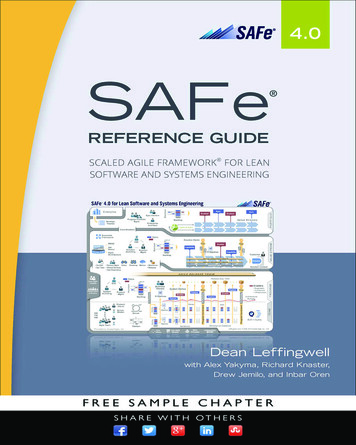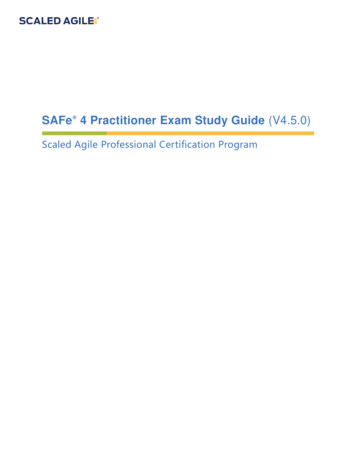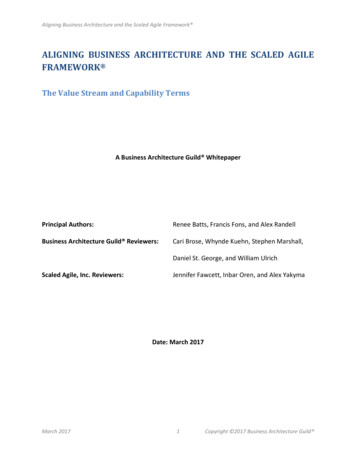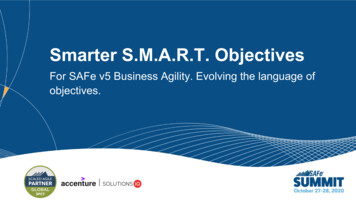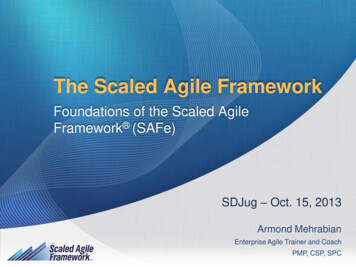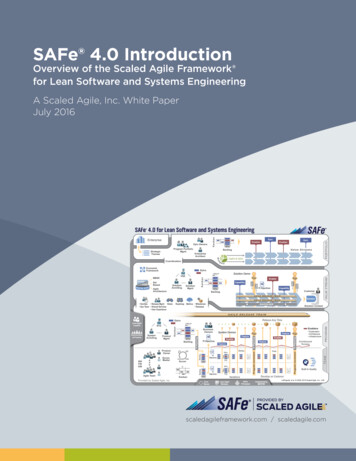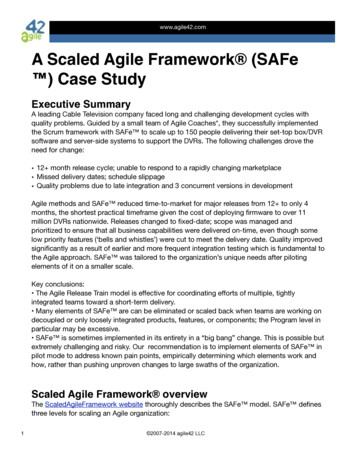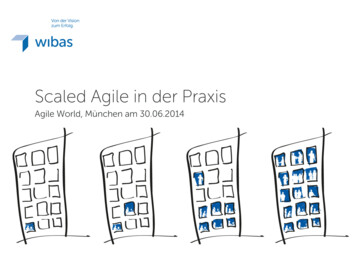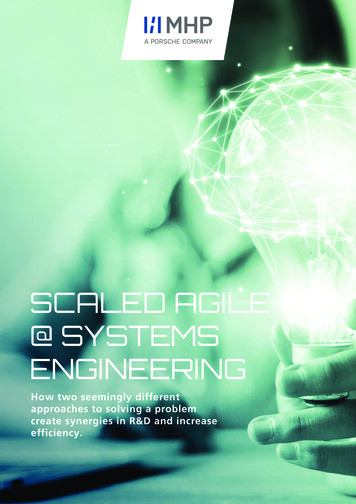
Transcription
SCALED AGILE@ SYSTEMSENGINEERINGHow two seemingly differentapproaches to solving a problemcreate synergies in R&D and increaseefficiency.
SCALED AGILE @ SYSTEMS ENGINEERING I September 2020Content01 Introduction 602 What Do We Mean by Agility? 803 What Do We Mean by Systems Engineering? 1004 The Synthesis, or: The Best of Both Worlds 1405 The Agile Systems Engineering Transformation 2406 Outlook IVITY3
SCALED AGILE @ SYSTEMS ENGINEERING I September 202001IntroductionAgility and systems engineering are an integral part ofresponsive, flexible product development.In recent decades, the business world has been characterized by volatility, uncertainty, complexity and ambiguity – or“VUCA,” as the concept is known for short. Driven by climatechange and the ongoing pandemic, this has recently beensupplemented by an additional acronym – “BANI,” whichstands for brittle, anxious, nonlinear and incomprehensible. Itforms a new framework in which volatility and complexity nolonger adequately describe the current shift from events thatare difficult to predict toward those that are entirely unpredictable1. Together, the influencing factors of both thoughtmodels present companies with the central task of adaptingto new framework conditions. This has a particular impact onthe area of R&D, which is faced with the challenge of having towork increasingly effectively and efficiently, while at the sametime, more responsive and flexible product developments arerequired.An example of this is the increasing degree of complexity in thedevelopment of mechatronic systems – not only is the numberof functional requirements increasing, but also the demandfor interdisciplinarity. The main drivers of this trend are digital technologies and the associated pressure to innovate. Themarket increasingly demands networking and data-drivenbusiness models. For system development, this means that traditional structures and interface-optimized processes must befundamentally reconsidered in favor of integrative approaches. Among other things, this is reflected in the change fromhardware-oriented development to a more function-orienteddevelopment. If companies have neglected this step in recentyears, this can often now result in delays to product deliveries,high reworking costs for content relevant to certification, oreven a complete lack of planned development scope.In the search for a solution to these and other challengessuch as short technology cycles, regulatory requirements and4employee motivation, R&D currently favors two models – systems engineering (SE) or the Scaled Agile Framework (SAFe ).Both models have their own strengths, but also reveal areasthat have not yet been taken into account and where furtherpotential can be tapped.The aim of this white paper is to present the profitable aspectsof both models in a joint synthesis and thus present a systemsengineering concept that is both agile (adaptive) and integrative. The central application for this lies in mastering technologically complex development projects that require fast andflexible adaptation options due to a dynamic or uncertain environment. The added value of this approach is also described inthe standard reference work from INCOSE (International Council of Systems Engineering), which has set up its own working2group to investigate agile systems engineering .1) Grabmeier, S. (2020): BANI vs. VUCA, Source: (https://stephangrabmeier.de/bani-vs-vuca/), as at: July 22, 20202) INCOSE (2015): Systems Engineering Handbook: A Guide for System LifeCycle Processes and Activities, Fourth Edition, John Wiley & Sons e know the theory and roles – how does theWpractical implementation work? How can our processes and tools be tailored to SEor agile methods? Synchronization with organization – how do wesolve the link to other areas? Agility has only worked in software so far – how canwe scale the model?The consistent implementation of the system concept in thedevelopment and organization, and the scaling of team principles at program or portfolio level often fail due to the standard processes and structures of a functional hierarchy (organizational structure). In practice, it is not sufficient simply todescribe the central roles such as System Architect, FunctionOwner or Agile Coach without enabling them to be integratedinto the organization and incorporating them significantly intothe processes. Therefore, this article will address the aforementioned questions and explain them using the combinedapproach as an example.The potential economic benefits are also highlighted below.The transformation takes place at individual speeds buttraditional organizations face similar obstacles, whichmust be overcome.A balanced combination of agile process models and systems engineering allows potential savings of 10 to 50per cent.In the practice of transformation, many companies have begunto implement at least one of the two models. However, theyare often stuck at individual stages. A non-representative survey conducted by MHP in July 2020 of 20 clients from varioussectors revealed five recurring questions with which companiesare confronted when implementing and anchoring agility and/or systems engineering:Three parameters are taken into account when focusing onpotential savings: quality costs (potential savings due to elimination of the need for improvements), time to market / costof delay (revenue and competitive advantages due to earliermarket entry of the systems) and innovation revenue (revenuefrom minimum viable products or unique features with innovative customer benefits). Of course, the potential depends onthe respective sector as well as the system complexity and themarket environment, and can only serve as a basic indicationhere. Further potential, such as higher employee satisfactionF or what should we use SE/agility and how will we benefitfrom it?(lower sickness rates, higher employer attractiveness and lowerturnover), was not included due to inconsistent measurementmethods used by the companies, but is a positive side effect.The following three main topics are distinguished for theimplementation of the approach and will be described in moredetail later in the white paper.1) Use of agile and systems engineering methods atteam levelIncrease in efficiency 10 per cent[Source: MHP project database].2) Transformation and scaling at organizational levelIncrease in productivity 20–50 per cent[Source: www.scaledagileframework.com]3.3) Introduction of an agile (adaptive) systemarchitectureIncrease in efficiency in complex systems 10–40 per cent[Source: MHP project database]Before these aspects are considered in detail, a uniform understanding of agility and systems engineering should be created.3) Scaled Agile – SAFe 5.0 , source: n-enterprises/), last updated July 22, 20205
SCALED AGILE @ SYSTEMS ENGINEERING I September 202002What DoWe Mean byAgility?Dynamic markets require dynamic companies.In the context of project and program management, the term“agility” is used to describe a wide range of approaches, methods and tools, some of which are used with varying degrees ofsuccess. Used by 54% of respondents, SAFe is the most commonly used scaling framework, ahead of LeSS and in-housesolutions4.In essence, however, agility does not describe the use of aspecific project management method, but refers to the basicability to respond effectively and competently to an increasingly uncertain and unpredictable operational environment. Tomake this possible, two basic principles are of central importance: Flexibility and adaptability.Transferred to a project, this means that changes are perceivednot as a disruption, but as part of the problem-solving process.However, in order to avoid arbitrary reactions and to ensurepredictable project success, agile process models have beendeveloped that reflect the work results and working methodsby means of short iteration cycles and recurring routines, andat regular intervals. In a competitive environment, agility istherefore the by-product of natural selection, based firstly onvariation and secondly on “survival of the most adaptable,” orthe most effective/efficient solution. Therefore, short iterationcycles enable partial solutions to be tested, developed incrementally or rejected as unsuitable. The result is a process ofcontinuous adaptation, improvement and learning.Hüsselmann5 has derived the central paradigms, principles andgoals of agility from the two core principles of flexibility andadaptability (Figure 1). They can also be found in the traditionalproject management standards, but are often not used muchin practice.4) Komus, , A. et al. (2020): Study Status Quo (Scaled) Agile 2019/2020, Koblenz University of Applied Sciences February 20205) Hüsselmann, C.; Maibach, M. (2020): Agilisierung des Projektportfoliomanagements (Agilization of project portfolio management).Praktiken und Rollenfür traditionelle Unternehmen (Practices and roles for traditional companies),WI [report] no. 012, Gießen/Friedberg: THM, ISSN e 1: Paradigms and goals of agility according to Hüsselmann67
SCALED AGILE @ SYSTEMS ENGINEERING I September 2020Paradigms in the change of disruption and ambiguity oftime.“Agile process modelssupport the application ofagile values and principles.They promote communicationand interaction, transferresponsibility to the affectedemployees and place greatvalue on functional projectitems, good collaboration withthe customer and willingnessto change for the purposes ofgreater customer satisfactionor a better product.”Based on our experience at MHP, we understand that manyparadigms that have created structure and stability in recentdecades are under scrutiny in a world characterized by VUCA& BANI. Instead, they must be replaced by adaptive and flexiblebasic attitudes combined with structured process models. Thisdevelopment relates to the following aspects:Numerous agile procedures and approaches have been developed on the basis of these principles in recent years. WithSAFe , a model has been established that is based on thesystem view and meets organizational needs, yet is adaptive,which is used here due to its prevalence.From ToThe management knows best The team knows bestLong-term strategies are irreplaceable Strategies contain adaptive componentsStrategies are for the customer Strategies develop with the customerThe plan must be adhered to Adaptation to changes may modify the planNo experiments or risks Change and error culture create innovationGPM Deutsche Gesellschaft für Projektmanagement e.V. (Hg.) (German Association for Project Management)(2019): Competency-based project management (PM4). Handbuch für Praxis und Weiterbildung imProjektmanagement (Handbook for practice and training in project management).Nuremberg: GPM Deutsche Gesellschaft für Projektmanagement, p. 16389
SCALED AGILE @ SYSTEMS ENGINEERING I September 202003What DoWe Meanby SystemsEngineering?Systems engineering not only helps companies to master the increasing complexity of product development; italso promotes interdisciplinary systems thinking.Systems engineering is a tried and tested approach for developing complex systems successfully – systems engineering isessentially as easy to define and understand as that.is far removed from an application in the actual project. Systemthinkers adopt a holistic approach when considering questions,and identify complex cause and effect relationships. Applied tosystems, the relevance of this approach for the implementationof the other building blocks can be understood and introducedin such a way as to add value. The role of the System Engineeris an important part of this.Four building blocks are fundamental to systems engineering.They cannot always be distinctly separated from one another,but they provide a full picture of the extensiveness of this topic:The systems engineering V model is also used outside ofsoftware development and provides the basis for agileproduct development.1) Systems engineering as a standardized discipline in aprocess modelIn addition, the V model (Figure 2) is often used to representsystems engineering – in many instances it represents a document-heavy, sequential working method. However, if the Vmodel is consistently embedded in the dimensions of time anddegree of detail, and defining characteristics such as the widthof the core area and the significance of the edges are takenseriously, a different perspective emerges. The V model leavesroom for iterations, supports modern view-oriented documentation of results and forms the necessary framework for thetimely mapping of system-critical aspects. The application ofthe core processes can be implemented almost as iterativelyand recursively as required throughout the development cycle,which supports the agile concept.At first glance, this approach seems obvious – it is largelyderived from “common sense.” This perspective describes systems engineering as an intuitive and practical discipline. Therise of systems engineering was motivated by the criticalityof early space travel and systems whose complexity increasedmore than their development methods could handle. Systemsengineering is used in particular when the complexity growsdue to the combination of new technologies, cross-domainfunctionalities and software-based, automated control. Thistechnical aspect – systems management – is standardizedinternationally as a process reference model for the development of complex systems and is defined in ISO 15288:2015and other accompanying ISO standards.2) Systems engineering as a modular method for thepractical implementation of the disciplineThe systems engineering approach includes a comprehensiveset of methods and the technologies for
tems engineering (SE) or the Scaled Agile Framework (SAFe ). Both models have their own strengths, but also reveal areas that have not yet been taken into account and where further potential can be tapped. The aim of this white paper is to present the profitable aspects . of both models in a joint synthesis and thus present a systems engineering concept that is both agile (adaptive) and .


